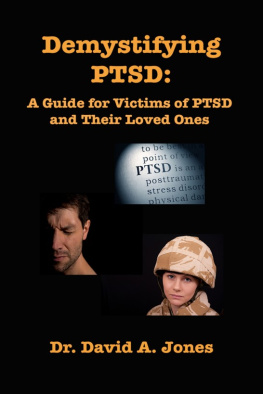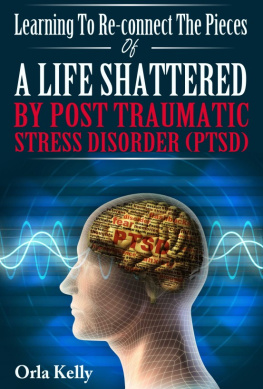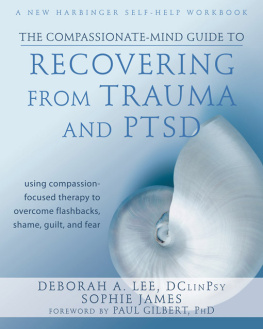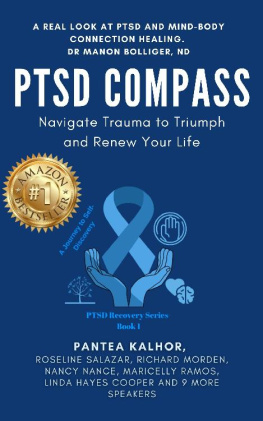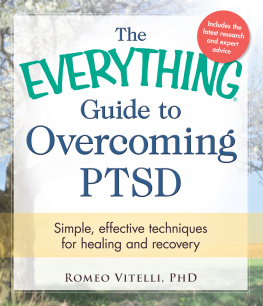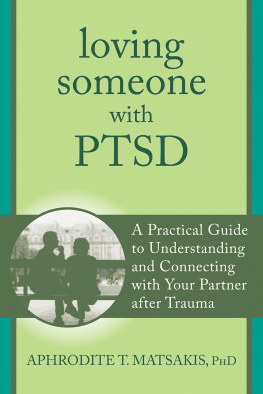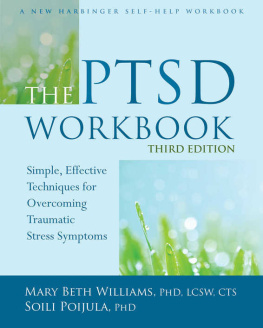Demystifying PTSD
A Guide Book for PTSD Victims and Their LovedOnes
By
Dr. David A. Jones

Apparently Normal Publishing
Copyright 2016 Dr. David A. Jones andApparently Normal Publishing
Distributed by Smashwords
This eBook is licensed for your personal use only.This eBook may not be re-sold or given away to other people. Ifyoure reading this eBook and did not purchase it, or it was notpurchased for your use only, then you should return it and purchaseyour own copy. Thank you for respecting the hard work of theauthor.
The author and publisher do not have any control overand do not assume any responsibility for third party websites ortheir content.
Cover art and photography:
Used under license from iStockphoto.com orShutterstock.com.
Cover designed by Dr. David A. Jones.
Ebook formatting by www.ebooklaunch.com
Published by:
Apparently Normal Publishing
Waterloo, Ontario, Canada
ISBN: 978-0-9948796-8-4
Version 2016/06/29
This book is available in paperback at mostonline retailers.
Demystifying PTSD is the result of a journeythat started for me while I was in Graduate School at theUniversity of Western Ontario. I'd like to express my thanks to mygraduate supervisor, Gary Rollman, for all of his wisdom andpatience, and for encouraging me to think outside the prevailingCognitive Behavioural box. I am also grateful for the guidance Ireceived from two very gifted psychologists and teachers, JackSweetland and Elizabeth Werth, who opened my eyes to the richnessof Object Relations Theory and psychodynamic concepts. Most of all,I owe an enormous debt of gratitude to Roger Solomon and KathyMartin, who enriched my EMDR skills by opening up the world ofStructural Dissociation Theory in their Art of EMDR workshops.
Waterloo, Ontario
June, 2016
Fiction
(Writing as Alex Jones)
WALLS: The Identity Trilogy, Book One
FACES: The Identity Trilogy, Book Two
ANGELA'S EYES: The Identity Trilogy, Prequel
Find out more about the Alex Jones Identity Trilogyat:
http://alex-jones-author.com/index.html
Table of Contents
In the first five years after I graduatedwith my Ph.D. from the University of Western Ontario (now known asWestern University) and started practicing psychology, I becameaware of three very important trends in my practice. First, Irealized that a large number of clients who came to me withprevious diagnoses of severe anxiety and depression, were actuallysuffering from Posttraumatic Stress Disorder (PTSD). Second, theCognitive Behavioral Therapy (CBT) skills that I learned ingraduate school were not working nearly as well as I would haveliked for these clients. Third, the way these PTSD victimspresented in real life was very different than the picture of PTSDthat was painted by DSM-IV, the prevailing diagnostic standard inNorth America at that time.
One of the most common things I noticed inPTSD victims was how upset these people were with themselves fornot being able to "just get over it". Most of them had beenfunctioning well in their jobs and their relationships before theyexperienced the trauma that triggered their PTSD. But suddenly,everything had fallen apart for them. They were baffled as to whythey were completely unable to cope with stress anymore, and whythey couldn't put their trauma behind them. I noticed that most ofthese victims beat themselves up badly because they felt weak anddefective, when they had previously felt strong and confident. As aresult, these people became even more anxious and depressed overtheir inability to solve the mystery of what had happened tothem.
Even worse, the relationships of most ofthese PTSD victims with their family and friends had deterioratedbadly. I noticed that victims had little tolerance for any kind ofsensory or emotional stimulation. They became incredibly irritableand tended to push their loved ones away. Their families and lovedones were mystified about what had happened to the person they knewbefore the trauma, and they were losing patience with them. PTSDwas destroying the lives of these PTSD victims and it was tearingtheir marriages, relationships, and friendships apart.
At that point in time, I started looking fornew psychological tools to improve my ability to help theseunfortunate trauma victims. A few years before this, I had heardabout a new therapy known as Eye Movement Desensitization andReprocessing (EMDR). My initial reaction at the time was that EMDRsounded like the psychology equivalent of snake oil in a travellingmedicine show. But my curiosity got the better of me as time wenton, and I did some research on EMDR. I found a surprising number ofreports that supported the new therapy as being an effectivetreatment for PTSD, so I figured that I might as well find out formyself what it was all about. I registered for the Level One EMDRTraining in Vancouver in November 2005, and I began trying out thenew therapy when I returned home.
Almost immediately, EMDR therapy opened myeyes to the real world of PTSD. I began to see the dynamic mentalprocesses of my clients unfold before my eyes, and I began to seePTSD in a very different way. Buoyed by my new enthusiasm, I tookthe Level Two EMDR Training in Calgary six months later.
Fast forward five years, and I now had fiveyears of experience using EMDR to treat PTSD. About this time, Istumbled upon an online article by Dr. J. Douglas Bremner, apsychiatrist and researcher, who described PTSD as being a diseasethat disrupts the normal processing of memories in our brain. Thearticle immediately struck a chord with me, because that's what myEMDR training had taught me, and it's exactly what I had seenrepeatedly in the PTSD victims I had treated over the previous fiveyears. As I thought about Dr. Bremner's article, I began to seesimilarities between how my PTSD clients described their impairedcognitive functioning, and how my computer acted when itsperformance slowed down drastically. As I thought about it more, amodel of PTSD started forming in my mind, using computers as theanalogy for what I saw happening in the brains of the people Itreated with PTSD.
Shortly afterwards, I began using thatanalogy of PTSD to explain the disorder to clients. I was surprisedto see how quickly my clients latched onto the model. I beganhearing the same thing over and over from them: "That's exactly howI feel. I wish you could explain that to my (husband, wife, orfamily)." These people had entered my office feeling overwhelmed,hopeless, and abandoned by the mental health system, and often alsoby their loved ones. But now they were leaving the office with anew sense of hope. Now that they had an explanation for how theirbrain had become overwhelmed, they were able to begin the processof not blaming themselves for their disorder. They now had hopethat their PTSD could be reversed with appropriate psychologicaltreatments such as EMDR.
Since then, I have used my informationprocessing analogy to explain PTSD to hundreds of new clients. Insituations where marital or family strife at home threatens myclient's stability, I often invite loved ones to a session where Iuse the model to explain PTSD to them. More often than not, thesepeople leave my office with a new understanding of PTSD and a newappreciation for how their loved one has been affected by thedisorder. It helps loved ones to be more tolerant and supportive oftheir family members while the victims move through their therapy.Since social supports tend to reduce the stress in the PTSDvictim's lives, educating families makes my job - treating theirloved ones PTSD - that much easier.

